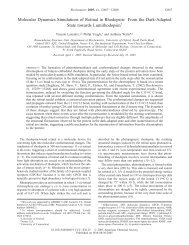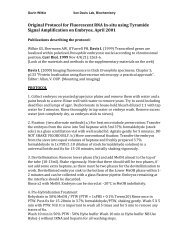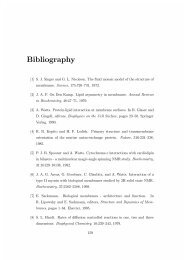Fluorescent Dyes and Proteins - Department of Biochemistry
Fluorescent Dyes and Proteins - Department of Biochemistry
Fluorescent Dyes and Proteins - Department of Biochemistry
Create successful ePaper yourself
Turn your PDF publications into a flip-book with our unique Google optimized e-Paper software.
Why use small molecule rather than<br />
genetically-encoded probes?<br />
1. No need to transfect<br />
hard for some organisms <strong>and</strong><br />
primary cells<br />
easier to titrate<br />
potential clinical applicatione.g.<br />
image-guided surgery<br />
MMP-activated Cy5 peptide<br />
labels tumour (RY Tsien 2010)<br />
2. Probes <strong>of</strong>ten brighter, with bigger signal to noise<br />
struggle to make GFP-based calcium reporter as good<br />
as fura-like dyes<br />
3. Probes with entirely different fluorescent properties<br />
QD photostability, probes with long<br />
fluorescence lifetimes, photouncaging<br />
4. Smaller<br />
e.g. calcium conc. right next to pore <strong>of</strong> ion channel<br />
36







